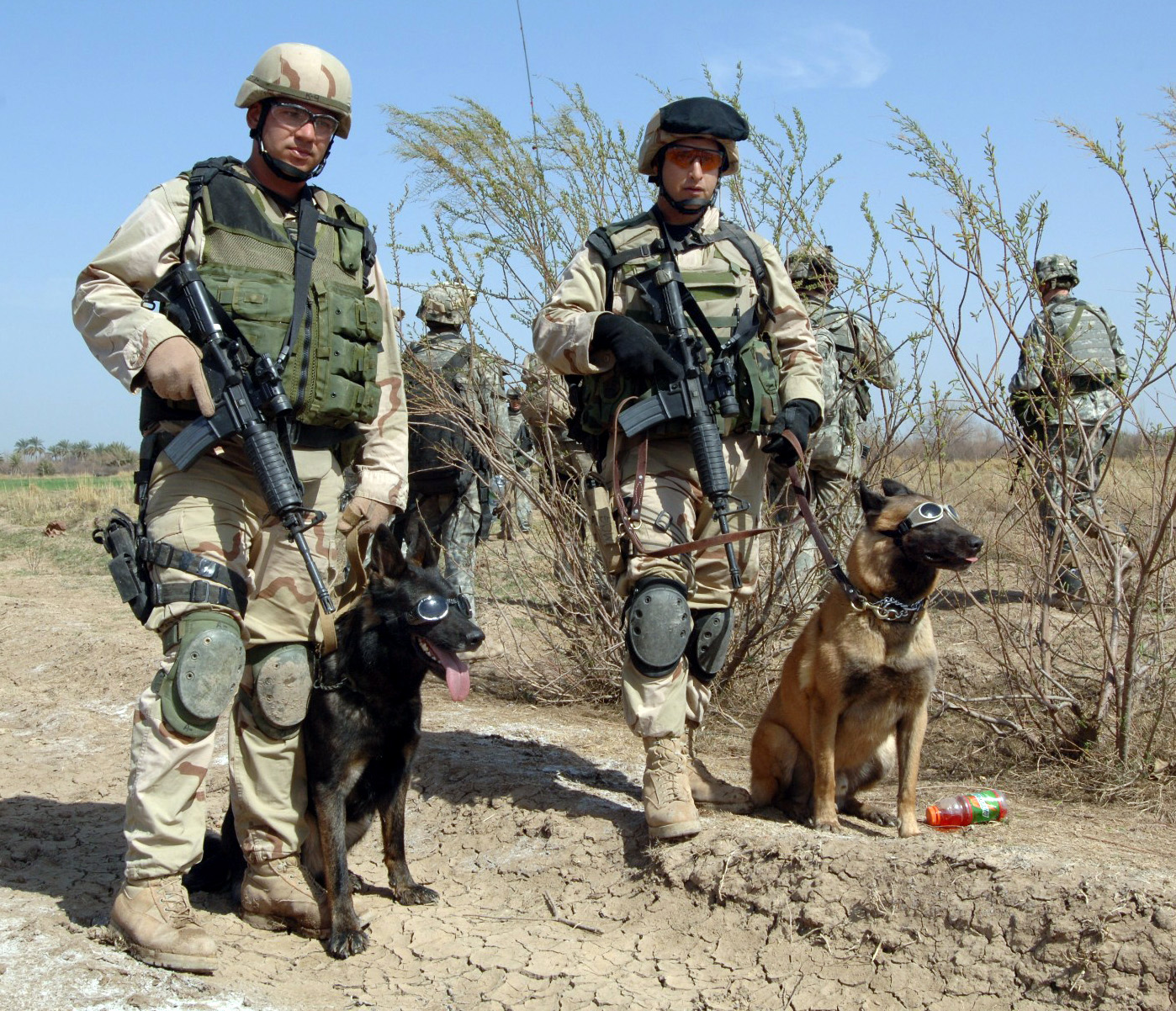Military Doggles - "You can imagine my delight when I put the system on my dog, turned it on, and it reacted to the cues. Up until that point, it was all theory," Pepper told Insider. "I was jumping up and down and beside myself. It was a really amazing moment."
Previously, military handlers had to use hand signals or lasers to direct dogs to areas of interest. However, this can expose handlers to enemy fire. Other systems, such as walkie-talkies, can cause confusion. Augmented reality allows the handler to digitally highlight objects for the dog's attention, eliminating one source of confusion.
Military Doggles
 Source: i.redd.it
Source: i.redd.it
Once the technology is working, "a handler can be sitting a mile away in a bunker, completely safe, and he can send the dog out and send the dog this very specific directional signal," The paper explained.
A Better Way To Talk To My Dog
Augmented reality is great for dogs, but the big question was whether the animal could actually do anything with the information they were being fed. "The overwhelming answer from the tests I've done is yes," Pepper said.
The augmented reality glasses invented by Pepper are connected to a command interface that allows the handler to not only see what the dog sees, but also interact with the animal in real time, making their interactions more efficient.
. Goggles allow army dog handlers to identify points of interest in the dog's field of vision without exposing the handler to enemy fire. According to an Army press release, feedback from the initial demonstrations "could fundamentally change the way military dogs are deployed in the future."
Taking a regular pair of Rex Specs goggles, already used by the military to protect canine eyes, Peper added an optoelectronic component, creating a screen where visual signals are transmitted to the real world. can be placed in a digital overlay to guide and guide it.
Source: content.12news.com
Animals When considering the potential applications of augmented reality headsets, Peper, who started a small technology company seeking to bridge the communication gap between humans and dogs, takes a very different approach. "Why not put HoloLens on dogs?"
He thought. To keep your canine partner safe and well-trained, you'll definitely need the police K-9 accessories we've featured here. We carry tactical dog gear as well as items that serve only to improve quality of life, such as an ozone-emitting "scent suppressor" to keep your K-9 transporter smelling good.
Tactical dog gear here includes dog goggles, mittens, leather and rubber boots, and other protective gear designed to prevent a dog's effectiveness in the field. We also have a series of modular components that are compatible with the dog's use, such as K9 lights, GoPro cameras, infrared K-9 lights, and more.
We also have a variety of clickers and whistles for use with K-9 training. And if you need to carry boxes for things like dog treats and exercise balls, we've got you covered. Browse our large selection of police K-9 accessories and tactical dogs today.
The next step in the development process for the canine augmented reality headset is to make the system smaller and stronger, as well as fully wireless, for rigorous field testing with special operations military working dogs, the high-performance animals expected.
It is assumed that they will adapt quickly. . New technique. Taking a regular pair of Rex Specs goggles, already used by the military to protect canine eyes, Peper added an optoelectronic component, creating a screen where visual signals are transmitted to the real world.

can be placed in a digital overlay to guide and guide it. The effectiveness of animal physical and vocal commands is limited when the dog is off leash and away from the handler, and there are serious concerns about the use of a light source that may be visible to an enemy.
Stephen Lee, a senior scientist at the Army Research Lab with a Ph.D. in Physical Organic Chemistry, told Insider that "If we could, in dog augmented reality, use a dot, like a laser dot, to guide the dog around a bend or a building.
goes to a specific location and we can see what the dog sees at the same time, this will help revolutionize how we use leashed military working dogs." Augmented reality is great for dogs, but the big question was whether the animal could actually do anything with the information they were being fed.
"The overwhelming answer from the tests I've done is yes," Pepper said. Thinking of new ways to talk to your dog, A.J. Pepper, the founder of Command Site, presented an idea that the US military says could revolutionize the way special operations forces train dogs on the battlefield.
Using a chest- or wrist-mounted monitor or laptop, Pepper explained, "the handler can view the dog's environment and click on any location or object in the environment that the dog points to. Want to attract attention."
Military working dogs are used for a variety of roles, from base security to bomb detection and tracking down enemy combatants in the field. In 2011, a US Navy special military working dog named Cairo participated in the raid that killed Osama bin Laden.
 Source: pbs.twimg.com
Source: pbs.twimg.com
These dogs can experience significant threats to their lives: In 2019, a Belgian Malinois member of Delta Force named Conan was injured during a mission to kill or capture ISIS leader Abu Bakr al-Baghdadi. Conan survived.
Since Mater had never worn glasses, it took him about a week to get used to them. It took another two weeks to train him to respond to a body laser, a common tool used by the military and law enforcement agencies to direct some working dogs.
It then took another week to transition from a physical laser to an augmented reality indicator. Before becoming an inventor, Pepper was on a career path in education, but after earning a Ph.D. In academic leadership, he decided to leave academia and instead became a consultant for emerging technology projects.
If a working dog had augmented reality glasses, however, a handler could provide instructions to the dog as it rounded a corner, went up a hill, or entered a building. And he can do so from a safe position without alerting the team's enemy.
Equipment presence or intended purpose of the dog. Working with handlers, military working dogs track narcotics, detect explosives and even attack enemy combatants. For example, Conan, a special forces dog who helped take down ISIS leader Abu Bakr al-Baghdadi last fall, was awarded a medal by the president.
When considering the potential applications of augmented reality headsets, Peper, who started a small technology company seeking to bridge the communication gap between humans and dogs, took a very different approach. "Why not put HoloLens on dogs?"

He thought. The effectiveness of physical and vocal commands is limited when the dog is off leash and away from the handler, and there are serious concerns about using a light source that could be visible to an enemy.
Working with handlers, military working dogs track narcotics, detect explosives and even attack enemy combatants. For example, Conan, a special forces dog who helped take down ISIS leader Abu Bakr al-Baghdadi last fall, was awarded a medal by the president.
Stephen Lee, a senior scientist at the Army Research Lab with a Ph.D. in Physical Organic Chemistry, told Insider that "if we could put a dot, like a laser point, into a dog's augmented reality, to guide the dog around a bend or to a specific spot in a building.
And we can see what the dog saw at the same time, which will help revolutionize how we use leashed military working dogs." Before becoming an inventor, Pepper was on a career path in education, but after earning a Ph.D.
In academic leadership, he decided to leave academia and instead became a consultant for emerging technology projects. The next step in the development process for the canine augmented reality headset is to make the system smaller and stronger, as well as fully wireless, for rigorous field testing with special operations military working dogs, the high-performance animals expected.
It is assumed that they will adapt quickly. . New technique. Thinking of new ways to talk to your dog, A.J. Pepper, the founder of Command Site, presented an idea that the US military says could revolutionize the way special operations forces train dogs on the battlefield.
 Source: i.pinimg.com
Source: i.pinimg.com
A military working dog wears doggles to protect its eyes during an air assault by U.S. Soldiers assigned to Alpha Troop, 1st Squadron, 172nd Cavalry Regiment, 86th Infantry Brigade Combat Team, Prawn, while a Chinook Haley
The copter takes off, kicking up dust and debris. , Afghanistan, 11 May 2010. U.S. Army photo by Sgt. Jason Brace Researchers believe they are two years from a fully functioning prototype. The current system uses Rex Specs, safety glasses already in use by military working dogs.
The system also uses wires, although the working version will be wireless. The research was funded by the Army Research Office, part of the Army Research Laboratory. The augmented reality glasses invented by Pepper are connected to a command interface that allows the handler to not only see what the dog sees, but also interact with the animal in real time, making their interactions more efficient.
. "You can imagine my delight when I put the system on my dog, turned it on, and it reacted to the cues. Up until then, it was all theory," Pepper told Insider. "I was jumping up and down and beside myself. It was a really amazing moment."
The idea that led Peper to start his company – developing a mixed-reality headset for dogs – came in early 2017, when Peper asked himself: “I want to bring the fun and exciting parts of technology to dogs and training.
How can I get in the spirit of? Command Sight, a small company that aims to provide AR goggles for military working dogs, has developed the technology to enable dog handlers to give instructions to the dogs.
are brought into their view, such as the location of potential explosives, caches, or enemy troops. In turn, the handler can see everything the dog can see through a camera in the dog's goggles. If A working dog may have augmented reality glasses, however, so a handler can provide cues to the dog as it rounds a corner, up a hill, or into a building, and that enemy.
could do so from a safe location without being alerted to the team's presence or the dog's intended target.